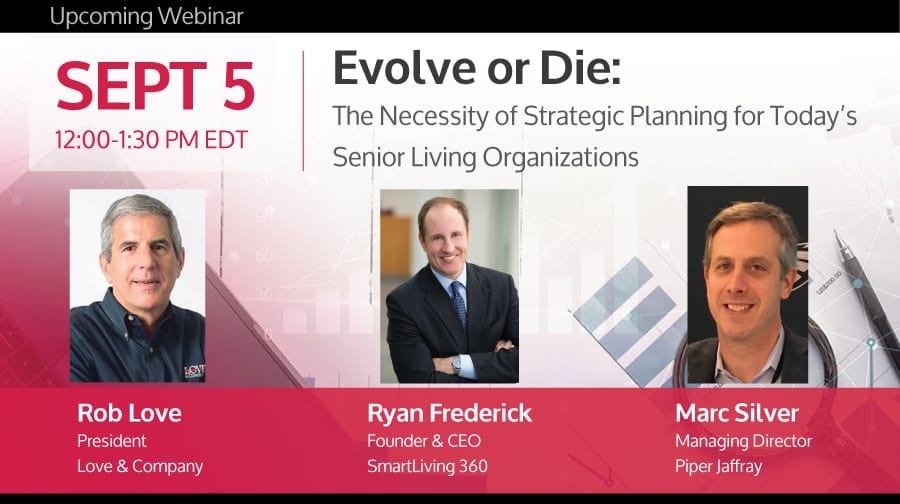Guest blog by Ryan Frederick, Founder and CEO at SmartLiving 360
Author and business management expert Robert Waterman once said, “A strategy is necessary because the future is unpredictable.” Like many businesses today, the senior living field is rapidly changing and this shift demands a different approach to strategic planning for senior living.
In the past, strategic planning was a long-term, linear-based process founded on a set of fixed knowns, but in today’s changing climate this method doesn’t hold water. Real-time developments like changing consumer preferences, product innovations and disruptive technologies, among other factors, leave senior living leaders with two options for the future: (1) have no plan, or (2) create an actionable, yet flexible plan.

This actionable, yet flexible approach requires you to evaluate and/or change your strategic plan every three to five years. Sounds fairly short termed, right? Well, let’s take a look at some factors that are unique to the senior living field.
Challenges facing our field and why you need to plan for them
Years of experience in senior living, real estate development, finance and healthcare services have made me believe that we must accept change in order to grow. Here are just a few examples of the challenges facing the senior living field:
- Growth of aging population and increasing longevity. With the influx of baby boomers into the existing senior population, older Americans will make up 21 percent of the population by 2035, up from 15 percent today. In fact, older adults will outpace children in population size at that point. Moreover, many people are living longer and often healthier lives. Living to 100 requires a new level of personal planning.
- Consumer preferences. The oldest baby boomers picture a different retirement lifestyle than their parents. Some may not even look to retire but choose to stay as active, engaged and relevant as possible. Boomers want walkable locations, a la carte contract offerings, health and well-being programming and larger housing floor plans. They are educated consumers with a strong interest in value.
- Affordability. With a greater life expectancy, fewer pensions and likely changes in Social Security, today’s seniors may not be able to afford the entrance fees required by Life Plan Communities and may seek less expensive housing options, particularly as new innovative products become available.
- Healthcare transformation. Healthcare is moving from a “fee-for-service” model to a focus on population health, where people receive the right care at the right place and the right time. Additionally, changes in Medicare reimbursements—to keep patients healthy and out of acute care settings—will prompt hospitals to look for skilled nursing facilities with similar admissions and readmissions criteria and quality measures.
- Technology. More and more services such as food, entertainment and transportation are delivered on demand and will a require a shift in the delivery of services within senior living communities too. Additionally, seniors will become more comfortable with technology, such as wearable devices and telehealth services, to manage smart homes and track health outcomes.
- New players in the field. Five years ago, the senior housing market wasn’t as competitive; however, many new entrants have emerged, including multifamily and mixed-use developers, adding substantial new supply in many markets. Further, we can expect providers to develop an increasing number of rental communities that offer a different value proposition and target a lower price point than Life Plan Communities. In addition, expect to see more “virtual villages,” co-housing, age-restricted or age-targeted apartments and other budget-friendly alternatives.
- Labor challenges. The recruitment and retention of staff are on the minds of every senior living leader, and the influx of the senior population will only intensify the need for increased staffing at all levels of care.
While navigating through the evolution of the senior living field is challenging, there is no better time for innovation and disruption. As people continue to live longer due to advances in healthcare and an increased knowledge of health maintenance, senior living leaders have vast opportunities to serve people and provide them with options to live well and purposefully.
A look in the mirror: Where does your organization stand?
The challenges require one to take a hard look in the mirror. At the very least, you must begin to ask yourself thought-provoking questions such as:
- Are your facilities up to date? Younger prospects want attractive and updated wellness facilities, dining areas and common spaces. In addition, Love & Company reports that senior living prospects no longer prefer one-bedroom, one-bath floor plans; most single prospects prefer a one-bedroom residence with a half bath and office.
- Are your communities located where people want to live? Are they in remote or rural locations away from strong labor pools, cultural hot spots and walkable destinations?
- What is your financial viability? Before beginning the strategic planning process, you must understand the financial strength of your organization for growth opportunities.
- How long has it been since you developed a strategic plan? Organizations have a tendency to focus on the annual business plan versus a true strategic plan where core assumptions are challenged and debated.
- Have we asked enough “what if?” questions? Are we aware of how sensitive our communities are to fundamental changes in the market in the near-term, medium-term and long-term?
- Are we positioned to be reactive or proactive in this changing environment?
The time for strategic planning is now
The business of not-for-profit Life Plan Communities is more sophisticated than ever before. Managing a continuum of care that includes independent living, rehabilitation, memory care and skilled nursing has an inherent complexity. But the challenges described here only add to the complexities surrounding our business.
To put it simply, now is the time to develop a strategic plan. In doing so, it will help you:
- Understand and forecast the impact that external challenges have on your organization
- Better assess your organization’s current capabilities and assets
- Map out and prioritize options to address upcoming challenges and opportunities
- Understand the resources, including financial, that are needed to implement the plan
- Create an actionable, yet flexible plan as the environment invariably changes
- Act while you still can
The cost of doing nothing will put you in a position where you likely can’t move quickly enough. This is especially risky for not-for-profits as strategic decisions require a collaborative approach between the executive leadership team and board of directors.
Unlike in the past, today’s strategic planning is a dynamic process that may not necessarily have a clear beginning and end. With the need for an evolving strategic plan, it may be time to engage outside resources for an unbiased look at your organization and market and be a devil’s advocate to identify opportunities for innovation.
Love & Company invites you to our 2019 Leading Edge C-Suite Webinar Series. Here you’ll learn from industry experts on how to stay ahead of opportunities as they emerge and redefine your strategic planning process. Register for the strategic planning webinar on September 5 for key insights.

—
Read the rest of our Strategic Planning Blog Series:
- Part Two, “Preparing to Plan” by Rob Love
- Part Three, “Financial Positioning for Strategic Growth” by Marc Silver of Piper Jaffray
- Part Four, “Two Approaches to Strategic Planning” by Ryan Frederick of SmartLiving360




